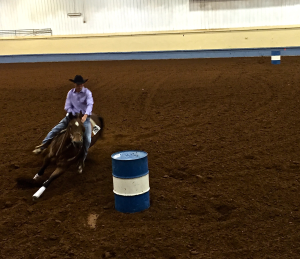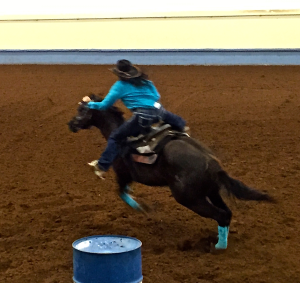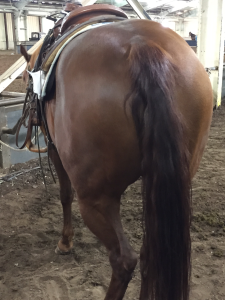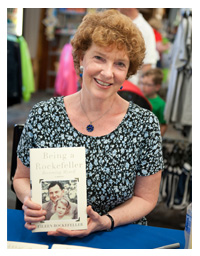Oklahoma City is known as one of three horse show capitals of the country. Wellington, Florida and Lexington, Kentucky are the other two. Unlike the scene in the other two locations, shows in Oklahoma City don’t attract many spectators. My horse trainer, Callie, and I were one of a dozen others who watched indoor barrel racing and pole bending last Friday. I learned that it’s all about the pacing.
The six or more round and rectangular barns which make up the show grounds —each as large as a football field— are packed full of modular horse stalls. It was surreal to see so many horses in the barns and warm up areas, yet have our choice of seats in the nearly empty amphitheater.
Despite the lack of spectators, I liked the informal atmosphere. Two men sat at a table in the judges’ corner close to the entrance, calling out the next contestant. From our seats we could see horses being mounted in the waiting area, accompanied occasionally by whinnies and snorts. The air was dry and smelled of peat moss. After five or more races, a tractor raked the ground to erase the deep pockmarks left by scrambling horses’ hooves.
Quarter horses are bred to turn on a dime. When herding cattle they sometimes have to maneuver in very small spaces, followed by mad dashes to turn the errant steers. Their work demands a lot of muscle in the hindquarters, as witnessed in the picture below:
One way quarter horses learn to maneuver in small spaces is by spinning around barrels and galloping full speed to the next. Another way is to practice “pole bending,” the equivalent of doing slalom on skis. I enjoyed the pole bending best because of the rhythm and grace of the few horses and riders who had learned to ride as a team. Take a look at this video:
You can see the “flying changes” on their front feet between each pole; a magnificent display of dexterity, strength and balance. The distance between each pole is carefully measured, as it would be in a ski race, to allow just enough room to change leads safely before rounding the next pole.
When I travel, I need enough space on either end to change my pace or I burn out. Life is sometimes like a series of pole bending races. We can race past obstacles to our goal at breakneck speed, but if we don’t have the internal strength or balance, we take the risk of crashing the course.
How do you pace yourself?





Interesting topic/video. Thanks for sharing. How do I pace myself? Good question. Relevant to us all. When I travel, I allow ample time (more than) to get to the airport, go through security and
find my gate. Then, I read a good book or listen to my iPod, with lyrical music, to keep me company while I wait. Since I tend to be a “white-knuckle” flyer, I continue reading or listening to music and recline my seat just a little. When I get to my destination, I bring my sheepskin slippers and fresh, percale pillowcase so I’ll be assured some comforts from home.
Pacing is very important especially if one tends to be an HSP (highly sensitive person). As Elaine Aron writes in her book of the same title, it’s important to pace ourselves, slowly and carefully, so we don’t feel anxious or burn out too quickly. Rest is important, too. I understand what she means and try to practice simplicity and mindfulness in daily living.
P.S. I wrote a comment, in your March 17th blog, about my experiences at the “Driving Immersion Clinic” in Temple, New Hampshire. Enjoyed a wonderful week of ponies, pleasure and peace!
Phyll, I have a lot to learn from you! Nice idea about listening to your iPod. I am also a white-knuckle flyer. I’ve found that if I do my iPhone card game, “Free Cell” it keeps me so present I hardly notice the take-off or landing. It works even better for me than a mystery!
And yes, for us HSP’s we need a lot of rest. I’m resting a lot now as I’m recovering from a cold. Loved your last week’s comment, and I wrote you back. xox, Eileen
I agree, Eileen, it’s all about pacing. I have a friend in her 90s who uses that phrase, as her body and schedule have slowed down. When my children were younger and I was working my speed was almost always fast. Now in my 60s I move more slowly, not because I have to. It’s more because being more mindful is where I find myself most content.
Susan I love your perspective, that you don’t move more slowly because you have to, but from choice. Mindfulness appreciates every bite of life. Thank you for sharing yours.
I’m not sure I’m good at pacing myself, but I certainly enjoy watching humans and animals working together in perfect unison. Great video!
Knowing you as I do, Randy, I think you were born with an “outpace” gene! Gotta love those hills when you’re on a bike!
Hi Eileen, My first read of your article elicited the thought that perhaps, you were thinking of entering a horse in the Kentucky Derby, or one of the prestiguous horse competitions! I, quickly, called an old “friend” whose family, generations back, had won The Man of War trophy and several
other horse trophies. I, exclaimed, “Please write to Eileen about your great great grandparents’
success in horse competitions”. Enthusiasm and hard thinking have taken me far,but temperance
has been my dearest friend. That is to say, my second reading of your article on barrel racing and pole bending and pacing” resulted in my picking up the phone, again to the same “friend” to say, “I misread Eileen Rockefeller’s blog article. Do not follow my advice.” A quick email from my friend said “Rock on”!!!! I guess I should be literal on the pace question you presented and reveal that I pace my daily walk to a METROnome. Maybe, my husband is buying me a new rock for my wedding finger– impossible in light of our youngest’s education costs and my unemployment…
I seem to surprise you Elaine, but I’m really not into prestige, but I do love an occasional horse race. You have given me a great idea for a horse’s name: Metronome! What should I call it for short? If I had a pair I could call them Metro and Retro!
Thank you for the Horse education. What beautiful horses. These are the quintessential “Cowboy Horse”, I guess. They look like the decathletes or Fighters/Gymnasts, as opposed to the Marathoner or basketball Player physique of the racehorses. It was Davinci’s Battle of Anghiari studies of Horses that made me want to draw initially. He drew them like people, as classical figures, with all the personality traits, and in that case with the fear and anger of the battle-field, which you don’t see much in equestrian studies. So I think Leonardo must have had a very special love for Horses as well. He drew them like his funny grotesque studies of bar people etc…
And great interview, crisply produced show and sound I was able to remove the high end and hear the English interview. German is a difficult language I thought, many more levels it seems, compared to the Latin languages. Like Cantonese compared to Mandarin.
Pacing, yes I agree, it can mean so much of the difference between a crash and a smooth sail, even each day. I early rise hours before leaving for the day. I’m trying to get the kids to get up earlier to start their days with some calm and preparedness, instead of the rush. But, a work in progress…
Pacing Story: Recently I tried to help my oldest son regarding this pacing and energy management issue, with regards to the Academic School term. He hadn’t been respecting the brevity of the “Pace”. So I told him this:
Imagine the term itself, like a 60+ foot monster wave coming at you, like Jaws in Hawaii or Mavericks in California, and it will be a 4 month ride, so respect it and do not treat it like a “normal” life/wave situation, as in: get the extra sleep and set study times/days etc… and eat well…
And even if some courses start to go, like a big Great White Shark coming up behind you, then even if it bites a chunk out of the back of the board (a course is dropped), then one must still keep calm, keep up the energy and pace, breath well, keep ones balance… and ride what’s left of the board right up onto the sand, with a slide-off-of-the-board walk-off and then drop into a beach chair, under a thatched umbrella,, complete with the fruit drink in the hollowed-out Coconut with the bendy straw and the little umbrella sticking out of it…and then he survives the term and kicks back until the next wave…
So last term there was a chunk bitten out of his board, but this term is better and he is more cognitive of the seriousness and demands of the school thing and pacing oneself as one tries to survive it. Also with Study, I have told them to also treat it like a special time and prepare for it and even reward oneself after with a treat or game or whatever and to treat each session, like at the Buddhist Temple, in a meditation session, as in treating it as a special focus time on something, even if that is Math.
Wow Timothy! I can see that this blog took your mind through its own pole bending–from German and Mandarin, to Great White Shark to Buddhist Temple. That’s quite a ride! That said I like your metaphor for helping your son pace himself. Did it help?
Thanks for asking Eileen, and yes it was an interesting ride learning about the Quarter Horse…the pacing helped my son a bit I think, as long as he can stay off of his Smart Phone… But yes it did help and they loved your bright thoughts on the leafless tree in the winter and seeing the “bright side” of it. Thanks for that…:) Best regards!
Actually, my mistake, Coconuts don’t have to be hollowed out…and never buy one on a Mexican beach called a “Coco-loco”, as it will be half-filled with Tequila…
Good to know!